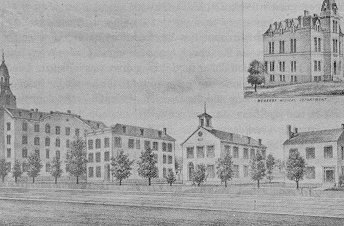MEHARRY MEDICAL COLLEGE (1876- )

Meharry Medical College originated in 1876 as the medical division
of Central Tennessee College, an institution established by the Freedmen's Aid Society of the Methodist Episcopal Church. The founder and first president of Meharry Medical College was New Hampshire native George Whipple Hubbard (1841-1921), a former Union soldier who received his medical degree from the University of Nashville. While still in school, Hubbard began the work of building Meharry, with himself as sole instructor, religious advisor, and superintendent.
Meharry's dental and pharmaceutical departments were organized in 1886
and 1889, respectively. There was only one member in the first graduating
class in 1890; he held the degree of Master of Arts. In 1910, the School
of Nursing of Mercy Hospital was transferred to Meharry. The Hubbard Hospital was built in 1917. On October 13, 1915, Meharry Medical College was granted a charter separate from Central Tennessee College, which had changed its name to Walden University in 1900.
On February 1, 1921, John J. Mullowney, a 1908 graduate of the University
of Pennsylvania and a former faculty member of Gerard College in Philadelphia, became the second president of Meharry. Under his leadership, admission requirements were rigorously administered; the number of faculty members increased; research and hospital facilities were expanded, increasing the bed capacity to 100; outpatient clinics were reorganized according to specialty; and a hospital superintendent was employed. In 1923, Meharry was given an "A" rating. With contributions from the General Education Board and the Rockefeller, Rosenwald, Eastman, and Carnegie foundations, together with assistance from the City of Nashville and Meharry alumnae, the college moved from South Nashville to its present location in North Nashville, adjacent to Fisk University.
In 1938, the distinguished scholar Edward L. Turner assumed the post
of press. Turner modified the curriculum of the medical school, insisting
on a more scientific approach and stressing the importance of proper clinical procedures. During this time, Meharry began to experience financial difficulties, which plagued the institution throughout the 1940s. President Turner resigned in 1944. Dr. M. D. Clawson served as president of Meharry from 1945 to 1950.
An interim administrative committee directed affairs until 1952, when
Dr. Harold D. West, the first black president of the school, began his
term. Under West, fiscal expansion was planned and a twenty million dollar
fund-raising drive was initiated. Land adjacent to the campus was purchased,
and a new wing was added to the hospital. Under a re-definition of purpose,
the School of Nursing and the Division of Dental Technology were terminated
in the early 1960s, and significant improvements were made to the curriculum
and facilities in the schools of medicine and dentistry.
From 1966 to 1968, Meharry was managed by an interim committee until
the dean of the medical school, Lloyd Elam, was appointed president. Meharry
then established a graduate school offering the Ph.D. degree in the basic
sciences and a School of Allied Health Professions in conjunction with
T. S. U. and Fisk University. New buildings for the schools of medicine
and dentistry and a new hospital building were constructed in the 1970s.
Elam provided Meharry with thirteen years of progressive leadership. He
continued his service to the school as a distinguished member of the teaching faculty.
In March of 1981, Richard Lester, chairman of the Department of Radiology
of the University of Texas Science Center and a member of Meharry's board
of trustees, assumed the duties of interim president for one year. In July
of 1982, David Satcher became the third black man to hold the position
of president. He served until 1993 and was followed by President John Maupin.
Meharry Medical College includes the School of Medicine, the School
of Dentistry, the School of Graduate Studies and Research, the School of
Allied Health Professions, the George Russell Towers of Hubbard Hospital,
two health centers, and the Harold D. West Basic Sciences Center.


